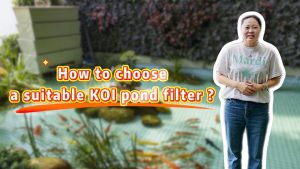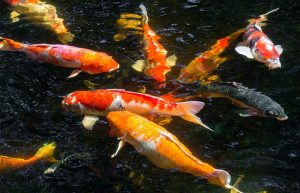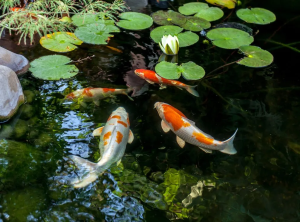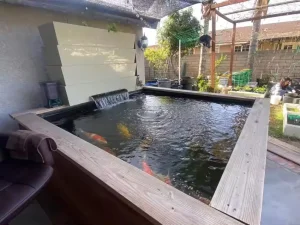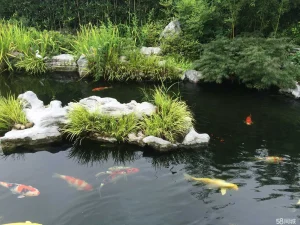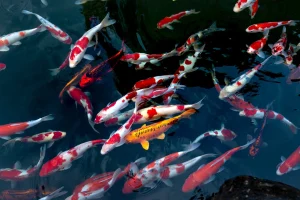The drum filter is one of the most ancient filters used in liquid-solid separation and the number one in mechanical filtration. Thisequipment, made of stainless steel, is the most affordable and essential solution for many sectors. It has a vital character in particle filtration with high flow rates at low load. Among the industrial processes, we have:
- aquaculture
- wastewater treatment
- REUSE
- wastewater treatment plants
- pre-treatment before biological treatment
- municipal and industrial wastewater treatment
- tertiary treatment…

What is the purpose of the drum filter?
In general, the drum filter is used for :
1.filtering water
2.remove suspended solids which can be feces, present in fish ponds, as well as colloids
With the filtering mesh, colloidal particles and other SS will be retained, as they will not be able to pass through and will simply sediment. These play a determining role in the filter and will allow to get rid of the TSS, by rinsing in the draining gutter.
The purpose of the drum filter is the same: to ensure the renewal of water and the mechanical filtration of impurities and fine particles. And this for :
- aquaculture
- aquaponics
- ponds
- or even the koi ponds,
In fact, thedrum filter can substitute for many natural filtration processes to ensure impurity-free water.
However, Many parameters are involved in the choice of a drum filter. That is, it depends on the size of your installation and your needs.

How does the drum filter work?
A drum filter is fed from the inside. The water loaded with particles passes through the filter cloth and comes out purified outside the filter.
The water flows through a gravity system or a pump to the drum filter. This is where the water is separated from the impurities. For this purpose, the drum filter is equipped with an automatic control that monitors this situation. This control continuously measures the water level in the drum filter. This is possible with gravity systems located behind the filter and pump systems located in front of the filter. As soon as the drum filter becomes clogged, the water level changes. In the gravity system, the water level drops behind the drum. In a pump system, the water level in front of the drum rises.
- 1.The water flows inside the drum, through the wall, to the outside of the filter drum.
- 2.On the drum side is attached a mesh whose size varies according to the solids present in the water.
- 3.This mesh filters the debris that is collected as mentioned on the inside of the actual drum.
- 4.During filtration, the drive motor that turns the filter drum is activated. This causes water to spray from the pressure injection pump through the nozzles and clean the drum.
- 5.The nozzles project water from the outside of the drum to the inside to remove the material collected by the drum.
- 6.These impurities are then evacuated through a chute through which the water flows to the drain.
How do you clean a drum filter?
The drum filter is equipped with an automatic self-cleaning system that allows it to clean itself.
Indeed, when the water flows into the middle of the drum, it brings with it all the detritus it has collected along the way, which is retained by the drum itself until the water flow is sufficiently restricted to lower the level in the drum and start the cleaning cycle.
However, sometimes after a long period of use, additional cleaning is necessary to keep the filter working properly. For this, it becomes necessary to perform manual maintenance.
Filtration VS Settling
The primary difference between settling and filtration is that settling separates two components in a mixture by pouring one component, while filtration separates two components by filtering one component.
Both settling and filtration separate the two components of a liquid-solid mixture or a mixture of two immiscible liquids by gravity. However, the filtration uses a filter paper or other suitable filter for this separation. In contrast, settling is simply pouring the liquid to isolate the solid or other liquid from the mixture.
In general, filtration is not a process that leads to purification. But it is accurate in relation to settling. Indeed, some solid particles may pass through the filter while some fluids may remain on the filter without reaching the filtrate.
What is the difference between clarification and filtration?
Clarification
- Clarification is referred as the removal of small amounts of solid particles from liquids
- Clarification is a process to clarify a liquid containing small amounts of solid particles by removing the solid portion of the liquid. There are different methods we can use to clarify a contaminated liquid.
- These methods include: filtration, gravity sedimentation, centrifugal sedimentation and magnetic separation.
- Some clarification methods involve a precipitation reaction
Filtration
- Filtration is a process that removes solid particles from a liquid by filtering it through a filter.
- Filtration is a process for separating a solid from a fluid by passing the fluid through a barrier that can retain the solid particles by a physical, mechanical or biological operation.
- The filtration method consists of filtering the liquid containing the solid particles through a filter such as a funnel or filter paper
- Unlike clarification, filtration does not require the use of the precipitation reaction.
Benefits of combining technologies
The combination of filtration and settling results in clean water free of fine particles. Both filtration and settling can be used to separate impurities from liquids, but there are differences between them.
Ideally, they should be combined for best results, starting with :
1.decantation, which involves pouring a liquid to remove solid impurities that have settled to the bottom of the container;
2.Filtration follows for the separation of the mixture of solid and liquid as it can be used to separate even smaller solid particles, which may not settle completely with sedimentation.
What are the advantages of the filtration technology?
The combination of filtration and settling results in clean water free of fine particles. Both filtration and settling can be used to separate impurities from liquids, but there are differences between them.
Ideally, they should be combined for best results, starting with :
1.decantation, which involves pouring a liquid to remove solid impurities that have settled to the bottom of the container;
2.Filtration follows for the separation of the mixture of solid and liquid as it can be used to separate even smaller solid particles, which may not settle completely with sedimentation.

